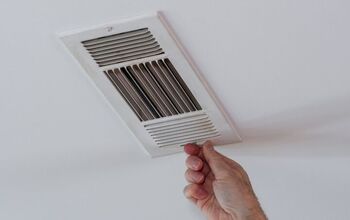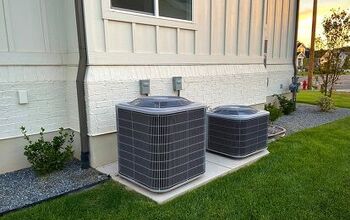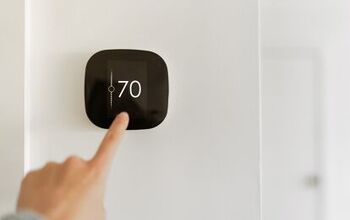Why Is The Dryer Blowing Cold Air?

Appliances such as washers and dryers are a modern necessity, but that doesn’t mean that they’re always easy to use. Dryers are prone to operational errors or unexplainable behavior just like any other appliance. So, why is your dryer blowing cold air, and should you be worried about it?
A dryer can blow out cold air instead of warm air if it overheats which is often due to a dirty filter. Lint and debris can clog a filter if you don’t clean it which blocks the airflow and can cause the dryer to overheat and blow cold air. A dryer blows cold air when overheated or the thermostat is broken as a safety measure so that it doesn’t catch on fire.
Luckily, it is easy to replace a dryer’s thermostat and reduce the risk of overheating. Never overload your dryer or you may cause it to overheat, blow cold air, and work poorly. Follow along as we explore what it means when your dryer is blowing cold air.
Do You Need Appliance Repair Services?
Get free, zero-commitment quotes from pro Appliance Repair near you.

Dryer Blowing Out Cold Air
It can be disconcerting when a dryer blows out cold air, especially when you need to get caught up on laundry. Dryers generally blow out cold air if they overheat, which may sound counter-intuitive, but that is the primary cause. Let’s take a look at the 2 main causes for a dryer to blow cold air.
Damaged Thermostat or TOC
Every dryer has a thermostat and a TOC, or thermal overload cut-out that help regulate the temperature. A TOC acts as a circuit breaker and it trips when your dryer overheats which causes it to blow out cold air or stop running. However, a damaged TOC can trip even when your dryer doesn’t overheat causing it to blow cold air, and you will need to replace it.
A damaged thermostat can also cause your dryer to blow cold air because it is connected to the heating element. The TOC and thermostat in your dryer are susceptible to wear and tear or electrical problems just like the rest of the dryer. Unfortunately, you typically have to replace a thermostat or TOC because it isn’t always possible to repair them.
It is easy to replace a TOC or thermostat as long as you shut off the dryer and keep track of the wire connections. Both parts connect to the heating element, so it’s important to work carefully so that you don’t damage it. You may need to replace the heating element as well if it doesn’t help to replace the TOC or thermostat.
Overheated Dryer
The main cause for a dryer to blow cold hair is that it is overheated. Dryers can overheat if you overload them or if the lint trap is clogged and blocking the airflow. It is unsafe to have a clogged filter or lint trap, and it can create a fire hazard.
The increase in pressure and temperature can cause your thermal overload cut-out to trip. Your dryer will blow cold air and won’t heat as intended until you clean the filter. It is ideal to clean your dryer’s lint trap after every load of laundry so that it doesn’t clog and prevent your heating element from working.
You can also overheat your dryer if you put too large of a load of laundry in the drum. It takes longer for a dryer to dry a large load of laundry, and it can also cause it to blow cold air. Experiment with your dryer and find out an ideal load of laundry so that you don’t overheat or damage your dryer.
Bad Heating Element
Heating elements go bad for the same reasons that dryers overheat, and they can cause the unit to blow cold air. The lifespan of a heating element depends on how well you maintain your dryer, and it can go bad in as little as 8 years. However, a heating element can last nearly 20 years if you clean the ducts and lint trap as much as possible.
A dirt lint trap or clogged ducts can cause your heating element to work harder than it is designed to. Over time, this can cause the coils on your heating element to go bad and ultimately stop working. Many dryers may still run if the heating element doesn’t work, but it will blow cold air.
You cannot generally repair a heating element, and you will need to replace it so that your dryer blows warm air again. Replacement dryer heating elements cost an average of $70, but they can cost as much as $200.
Replace the Thermostat and TOC
To verify that both the TOC and thermostat have failed, you’ll want to check whether or not there is a circuit between them. You can do this by using a continuity test meter. If no circuit is present, this is confirmation that the TOC has tripped.
Once you’ve verified that this is the reason for your dryer blowing cold air, unplug your appliance and locate the thermostat. You’ll find the thermostat underneath the back panel of your dryer. Remove the back of the dryer to access it easily.
You’ll be able to recognize both the TOC and thermostat by their small round, bottle top like appearance. They will also be screwed down to the machine and have wires attached to them. Engage in the following steps to replace both the thermostat and TOC:
- Dislodge the wires from the TOC and thermostat
- Unscrew the faulty devices
- Using your replacement TOC and thermostat, screw them in place of the old parts
- Locate the metal arms on either side of the components.
- Attach the wires you dislodged to the metal arms. This step is essential as these wires serve as the connection to the heating element.
- Close up the back of your dryer
It’s as easy as that! Keep in mind that while most TOCs can be found under the dryer’s back panel, depending on your particular model, it may be located in the front. If this is the case, these can be rather difficult to reach when they’re in the front. Consider calling a professional who will be better equipped to manage the issue.
Related Questions
What makes a dryer overheat?
A dryer can overheat if the lint trap is clogged or if there is too large of a load of laundry in it. The ducts can get clogged with debris that increases the air pressure and temperature as it blocks the airflow. A damaged heating element or damaged wiring can also cause a dryer to overheat, and it is a fire hazard.
How long should a dryer heating element last?
The average dryer heating element lasts for 13 years, but it varies based on how well you maintain the dryer. Heating elements can last up to 18 years if you regularly clean the lint trap and ducts. Burnout can occur in less than 10 years if the coils overheat or if the dryer shorts in some cases.
Summing It Up
Your dryer is likely blowing cold air because it is overheated. Dryers overheat when you put too heavy of a load of laundry in or if the lint trap is clogged. Clean your lint trap every time that you use the dryer so that the ducts don’t get clogged and overheat your dryer.
Inspect the thermostat and TOC to make sure that they are still working if your dryer blows cold air. The TOC can trip if your dryer overheats and you may need to manually reset it or wait until it starts working again. Otherwise, your dryer may blow cold air if the heating element is over 13 years old and is worn out.
For more common dryer issues check out, “ Dryer Making Loud Noise? We Have a Fix (Ultimate Guide)” and “ How to Vent a Dryer in the Middle of the House.”

Jessica considers herself a home improvement and design enthusiast. She grew up surrounded by constant home improvement projects and owes most of what she knows to helping her dad renovate her childhood home. Being a Los Angeles resident, Jessica spends a lot of her time looking for her next DIY project and sharing her love for home design.
More by Jessica Stone



























